If your progressive lenses are not working as expected you will find out here what is wrong and how it can be fixed with my troubleshooting techniques.
In this article, you will learn exactly what could be done with the centration and the lens design to center the reading zones to maximize the middle and near range distance width. If centration or lens design is not your problem it can be the lens power itself. With easy to understand illustrations, you´ll be able to get some hints on how to solve your problems.
Understanding the Design of a Progressive Lens to Solve Problems
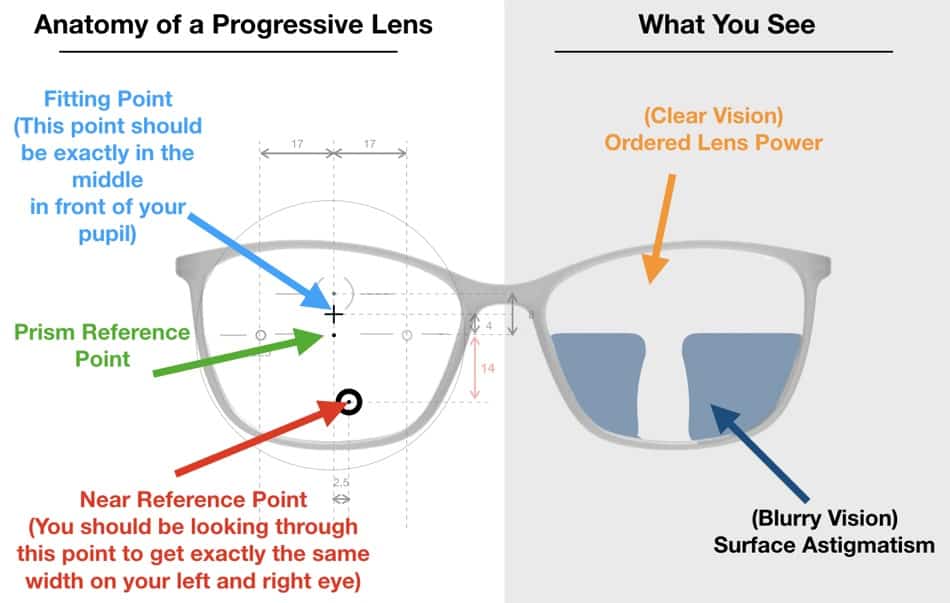
In this picture above you have the most important spots marked up on the left side in a progressive lens. On the right side however you can see what you will experience looking through the progressive lenses. What is pretty obvious to see the upper half of the lens will give you a lot of widths to perform eye movements in the horizontal and still get a clear vision.
As you lower your look to read or to look something up on your laptop you should use the lower half of the progressive lens design. And if this corridor for clear vision is not perfectly centered for you blurry vision will set in immediately. This is the reason why:
If problems come up in progressives it is mostly in the mid-distance or in the reading distance.
Side note by me.
What oftentimes causes trouble, in the beginning, is the amount of surface astigmatism on the sides. It will always produce blurry vision as you look through these areas. As you are younger there will be less surface astigmatism because of a less needed reading power. As you need more reading power surface astigmatism will increase and will decrease the width of your reading zone.
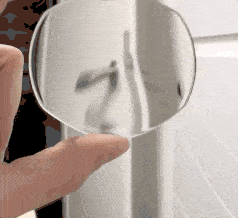
In the picture above you can see the different zones of the progressive lens as I move my hand with the lens further away or closer to the camera. No manufacturer in the world is able to produce your progressives without the surface astigmatisms. That is really important to understand for you.
But what we can do is to benefit from the advanced technology of the progressive lens manufacturers and optical shops to make your progressives as good as they can be and center the mentioned points as perfectly as humanly possible in front of your eyes. Because only then you avoid:
- headaches
- neck pain
- not wearing your progressives
- being able to read-only with one eye at a time
- having an extremely long time to adjust to your progressives
- dizzyness
- double vision
Is this article here a bulletproof way for you to not experience any of the mentioned problems? No. But you will get the instructions on how to minimize those effects. So you can adapt to the lenses as easily as you can. In order, to avoid the mentioned problems as well as possible we start with the easiest thing in the beginning.
The frame needs to be adjusted before the optician makes the centration for your progressives. This is when an iPad is used to make a photo of you or you are standing in front of a measurement device that makes a photo or video from you to check where your eyes are behind the frame. So if the frame is sitting askew in the beginning everything afterward can not fit perfectly.
In the next part of the article, we will discuss problems with your progressive glasses that may arise if they are already made and they just sit poorly in your face.
Troubleshooting Problems in Progressives Due to a Poorly Fit Frame

What you can see here in the picture above is a picture with a perfect position of the frame the points of the progressive lenses sit where the should sit directly in front of the pupil of our model.

In the picture above the progressive glasses are fitted too high. With this setting, reading will be quite easy to read and maybe you can see good indoors but outdoors everything will be blurry. To compensate for the poorly fitted lens in this case people oftentimes must lower their chin excessively in order to look through the correct spots of the progressive lenses for distance vision.
This is of course is not correct. The lenses are made in a way so you can see clearly in the distance without changing your posture.
What also happens with your progressives sitting too high is you are looking through the upper beginning of the corridor which is the spot in progressives with the smallest zone to perform eye movements from left to right. So you will be quite restricted in your eye movements if the frame sits too high. The solution is, in this case, to adjust the nose pads or the temples so the glasses sit in a lower position.

If progressives sit too low like in the picture above you will tend to compensate for that with an excessive raising of your chin to get into the reading zones. Otherwise with a normal posture and a normal eye movement down you can not use the reading zones. They are just too low.
This sometimes happens in the centration process. The measurement devices oftentimes have a mirror and behind it is a camera. What happens when you look in the mirror is you position yourself a little bit more upright in order to look good. But what happens is you also change the position of where you actually look through the lenses with your normal posture.
The picture of the device gets made and the position of your lenses is now too low. In some cases, you can change the position afterward by adjusting the nose pads. But if this is not possible new lenses need to be manufactured to solve the problem.

If your progressive glasses sit sideways like in the picture above the temples are probably poorly adjusted or the nose pads (if they are on your frame) do no position your frame in a symmetrical way on your nose. You will experience clear reading just on one eye if you open a book. Some people, tend to compensate for that with a turning of their head but of course this needs to be corrected to avoid neck pain. The same is true for the settings before.

When the whole frame sits on your nose a little lower on one side compared to the other side you are looking through different zones of the lenses. Here, in this case, the right eye from the man in the picture looks through the part of the corridor that is made for the middle distance.
So everything further than a few meters away is blurry on this eye. The other eye experiences clear vision in the distance (in most cases if astigmatism is not high). But you can not expect a good depth perception. This poorly set frame will lead to more falls in the elderly for sure with this setting.
This is something we see quite often. Especially in nursing homes.
Side note from me
The solution here is quite easy to spot. With an adjustment of the temples, the frame will be set in the position where it should stay. And the wearer will get a clear vision again in both eyes. One thing that is not so obvious is the fact that a frame sitting like this could lead to double vision or a twitchy feeling. The reason is the prismatic side effects you can see in the picture below.
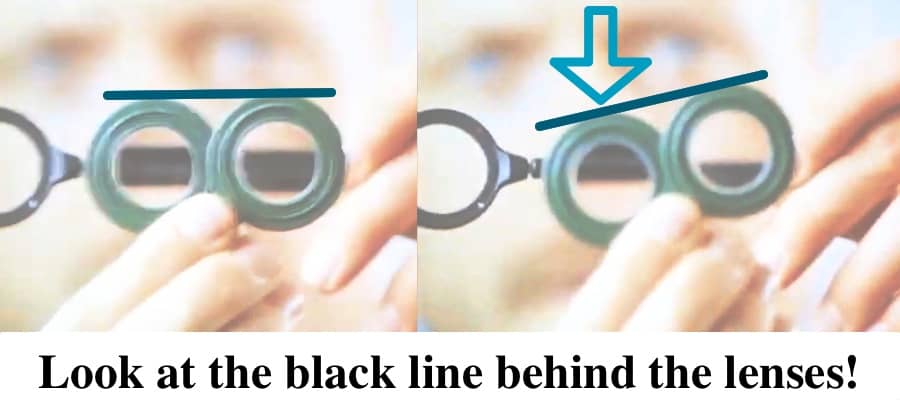
As you can easily imagine walking the stairs with progressive lenses set up in an oblique way like this would be a nightmare. You would think the stairs would be higher or lower than their actual position and then begin to stumble.
All we could see upon now was the position of the frame from a perspective directly facing the wearer of progressive glasses. However, if everything should be checked this will just not cut it. Therefore the glasses should be always checked from the sides and above. The reason is different widths of your reading zones could occur if the frame sits nearer on one eye compared to the other.
Side not from me. Always check how the optician checks the frame.

If the glasses sit in your face like in the picture above on the left side you can expect to get different widths of clear zones. The reason is easily understandable as you think about a keyhole. If you move very close to it. The width you can see gets as wide as possible. As you increase the distance to it the field of view gets very small. The same will happen with your progressive glasses. They should sit as balanced as possible in your face.
The same is true for certain angles and distances that are set to an optimum. In most progressive lenses the optimum tilt of the frame you can spot below is 8°. Some manufacturers will give you a range. But the best vision is just in one position of the glasses in front of your eyes. If this position is altered blurry fields in your progressive lenses will also change in form and intensity.

Having served my apprenticeship as an optician from 2003 to 2006 I corrected so many fits of progressives. And this quick look from above gets oftentimes overlooked. So make sure it fits evenly to avoid problems.
Problems in Progressives Due to Poorly Fit Lenses in the Frame
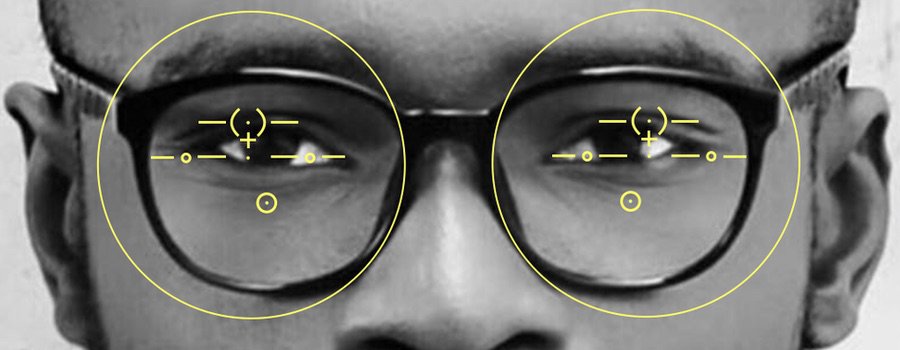
When the pupilar distance was measured too wide (dependent on how wrong) compared to your real pupilar distance you can not find the reading zones as you lower your look to find the clear areas. However, if you close your right eye and keep your look with your left eye on the reading but you can only see it sharp if your head is rotated to the right the centration is messed up.
If your visual acuity is the same on both eyes it is always the goal for the optician is to give you the same clear zones for both eyes simultaneously as you look down on something in front of you to read it.
Side not by me
Simply put it is just not possible to perform eye movements wider than normal to get into the right zones for reading. If you can not read right from the beginning something is wrong. It may be weird in the beginning with your first progressives and it can feel restrictive at times but you should be able to read and see clearly into the distance before you leave the optical shop.
You can not adapt to the lenses that are too wide apart from each other. The same is true when the progressive lenses are too narrow positioned in the frame for your actual pupilar distance. Not only do you have the disadvantage of smaller fields of view in the reading zone but prismatic effects, as shown above, will make it hard to adjust to those glasses. (The picture with the black line behind the lenses above)
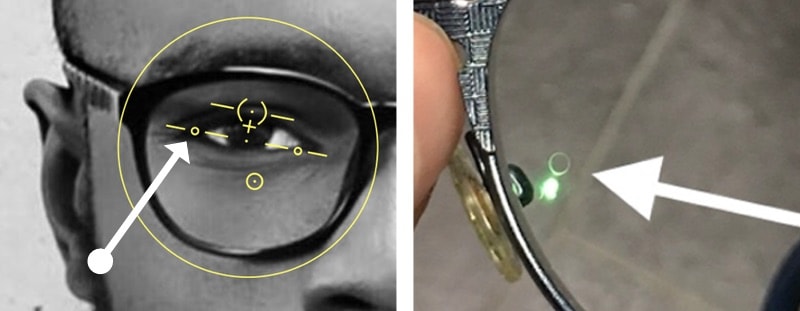
Usually, if the whole lens is positioned rotated in the frame none of the mentioned distances work. If you are not an optician you may have a hard time spotting the little engravings in the lens I marked up with white arrows in the picture above. But as you spot them you can see if they are aligned horizontally which would be perfect or if not the lens must be rotated if the frame if the form is round or you would need to get new lenses.
Problems in Progressive Glasses Due to Wrong Lens Design
All you read about up until now were problems caused by the wrong position of the whole lens in the frame with a fixed setting of the clear zones in your progressive lenses or the whole frame. This, of course, is totally the job of your optician. But did you know with more advanced progressives the reading zones can be placed in an optimal spot for you? If your eyes are more apart than average or more narrow this comes in really handy for you.
The reason is the placement of the reading zone will be optimized to how your eyes are positioned. Think about it if you look at something in close range your eyes wander down and more toward your nose. But that movement is not the same for someone if his eyes are more apart from someone who has an average distance between his eyes.
This feature is called Inset optimization and will work in your favor to produce more width in the reading zones to perform more eye movements from the left to the right while reading. But this is not the only factor when it comes to the potions of your reading zone.

What you can see right away in the picture above is the colored zones are positioned more oblique on the left and more straight down on the right. This is exactly what I meant by the different placements of the reading zones with the inset optimized progressives. As data of the frame is added and in which distance you read those reading zones get further enhanced for you.
You need to keep in mind when ordering your progressives they can be just optimized for one reading situation. If you like to hold the book closer to you in your hand this makes a difference compared to when you like to place the book on your desk while reading. Each reading distance will lead to other optimizations if you choose a lens design that can work with the mentioned data.
One thing you can get in nearly every lens is to shorten or lengthen the corridor of the progressive lens. If you have a hard time raising your chin and the centration part of the lenses is already perfect you might want to choose a shorter lens design. With a shorter lens, you get into the reading zones faster.
Of course, this sounds good but it comes with a downside. You miss a little bit of the middle distance and the corridor of the progressive lens loses a little of its width with every millimeter you order them shorter. In most lens designs out there you can choose between three corridor lengths:
- Short
- Medium
- Long
For people that are generally smaller, I would not recommend long progressive lenses. The reason is smaller people oftentimes feel they need to force themselves to reach the reading zone with a long progressive lens corridor. A Medium-sized corridor oftentimes will feel more natural if you are shorter than 1,80m.
If you can not adapt to Progressive Lenses Due to Wrong Lens Power
If your visual acuity is the same in both eyes you can expect the same sharp picture in both eyes. This will be tested during every good refraction to ensure the fastest adaption process. Now there are a few things to consider. The actual lens power is changed from the test set to make the lenses fit for you. So slight changes are totally normal. (The following chart will explain what I mean)
What can happen in some cases your progressives tend to hold a little bit too much plus power which makes the distance go slightly blurry. This should not happen but in some, an altered lens power of 0,10D too much can lead to such an outcome. For most people, those changes are not visible but for wearers of progressive glasses with visual acuity better than 20/20 (yes that is possible) it is definitely perceivable.
These changes not only happen in the distance but with your reading zone too. As in this chart below here. Like I said changes in the lens power are totally normal but in some cases, manufacturers can exaggerate this process in combination with their wish to deliver the widest view possible. Because if you add just slightly too much plus to the distance part and slightly less plus to the reading zone part the transition in the upper half compared to the lower half of the lens gets smaller. Thus the corridor gets wider.
| SPH | CYL | AXIS | ADD | |
| Ordered Lens Power | +0,00 | +1,25 | 6 | +2,75 |
| Actual Lens Power | +0,04 | +1,14 | 7 | +2,54 |
In a lot of cases, people really like that. But the changing of the lens power in the corridor is of course general approach to fit most people’s expectations/needs. But if the time is spent during the measurements to really check if the person can see beyond 20/20 vision this attempt might not fit the expectation and the lens power needs to be adjusted.
Luckily the manufacturers provide you therefore with an adaptation guarantee. So you can test the manufacturer’s approach without any risk. (In most cases, just ask the optician before you order your glasses)
As you need more reading power with time (usually the Add value remains static at around +2,25) your field of view will get smaller. The crux of the matter is these days is things need to be cheap and in an optical shop, things get cheap if the refraction is done in 5 minutes and consultation too. When the refraction is done in this fashion the optician has no time at all to check back if a little lower Add value would provide you just about the same clear near range focus but with a wider view.
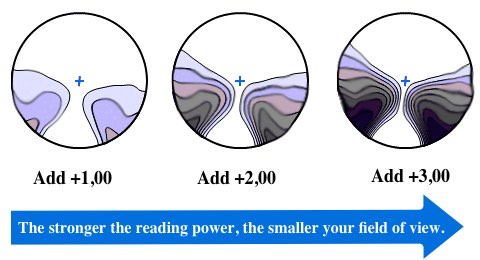
The Add value needs to be checked if it is not too strong. During the refraction, you might think everything is totally fine because you can read perfectly with an Add value of 2,00D. But if you could read just as comfortably with an Add value of 1,50D the possibility for you to perform eye movements to the left and right while reading will be restricted if the Add of +2,00 gets chosen. And of course, this would be just unnecessary. And who wants to be restricted if no benefit is given?
What about problems to adapt to Progressive Lenses Due to imbalanced Lens Power?
When the refraction is made for your left and right eye oftentimes lens power differs from your left to the right eye which is not a big deal in the testing frame. The reason is the lenses put in front of your eyes are centered directly in front of your pupils. This process ensures prismatic effects are not produced as you read out the test for your visual acuity. So this sounds important, right?
The funny thing is this is not what you get when your progressive glasses are made for you. In the picture below I marked up the points in which the prismatic powers get measured. And in progressive lenses, they are always decentered lower than your pupils. What you can expect are prismatic effects as you perform eye movements that can totally differ from the experience you had with the testing frame.
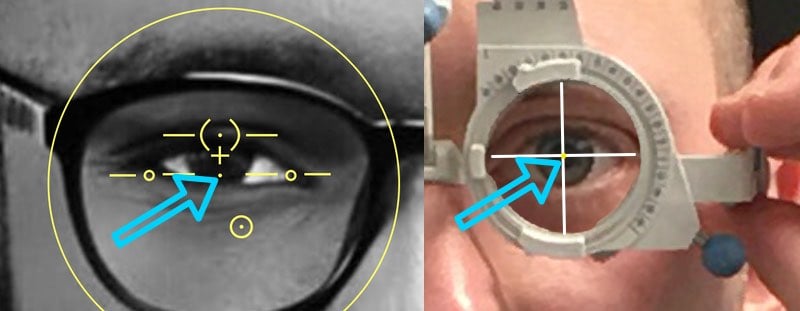
As this whole text is written for you as an actual wearer of progressive glasses I will not go into the mathematical details too much and jump straight to the solution on how to minimize those effects:
- Dropping the height of the progressive lens corridor (use a short lens)
- Using a contact lens in combination with your progressives
- Get a slab off (a special grinding technique that adds a fine line to the lens)
- Using prisms to compensate vertical imbalances
All of the three bullet points are valuable options and should be mentioned as a solution during the consultation. If contact lenses are combined with progressive glasses you have the whole list of options already mentioned on this website. You can choose the lens design get a long progressive lens to ensure you get the most out of your middle distance which can come in handy as you like to use your progressives while working with a laptop.
If you prefer to have the other options which are a short progressive lens design or a slab off you will lose the size in your corridor which gives you the lens power for the middle distance. In such a case it might be a good idea to get a second pair of glasses for your PC work or reading.
If all this has been checked and the reading zones still do not work
Problems with Progressives due to dry eyes
The picture you see of the reading zones in the shop is also highly dependant on your eyes tear film. If the quality changes and dryness or a tearing eye bothers you all the time I do not expect great results from the get-go. The picture below shows the results of how long it takes for the eye to dry up on certain spots. If this time is quite low like 4 seconds I expect the surface to constantly change a little bit on your eye.
But you can fit progressive lenses optimally just for one setting. That is it. This is more a thing of if your optician educated you about the status of the tear film to avoid a wrong expectation from your side. By the way, if something is made for your eyes your eyes should get a quick look from the optician before the consultation starts.
Problems with progressive lenses due to two different astigmatisms for near and far vision
In such a case if two different astigmatisms are needed the progressive lens has to change its needed progression in the corridor as you look down. Some people feel extremely restricted in the reading zones. As testing of the eyes goes a little deeper the whole refraction is done in the reading distance again. What comes out is different astigmatism during reading and the distance vision is needed.
This happens if your eye’s lens rounds themselves not perfectly but asymmetrically as you look into the reading distance. So astigmatism gets induced by you accommodating onto the close range. I have seen more people having this issue just in one eye. As they look into the distance the following testing chart looks like the left picture. Every line appears pretty similar to the rest in its intensity and sharpness.
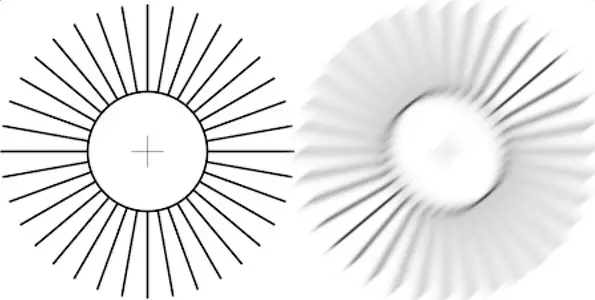
However, if you move closer to the testing into the reading distance the same picture could be seen in a radically altered way. If this happens and everything in this article was already checked you might need a progressive lens with two different astigmatisms. If you have it the right picture will look a lot more similar to the left one.
If you made it all the way to the end your problems with your progressives are pretty severe. It was a pleasure writing about the troubleshooting of progressive lenses. As always I wish you the best.

